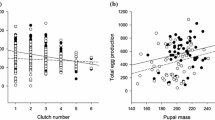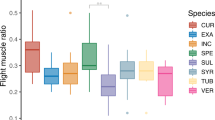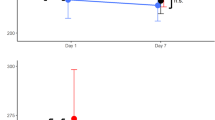Abstract
Allocation of larval food resources affects adult morphology and fitness in holometabolous insects. Here we explore the effects on adult morphology and female fitness of larval semi-starvation in the butterfly Speyeria mormonia. Using a split-brood design, food intake was reduced by approximately half during the last half of the last larval instar. Body mass and forewing length of resulting adults were smaller than those of control animals. Feeding treatment significantly altered the allometric relationship between mass and wing length for females but not males, such that body mass increased more steeply with wing length in stressed insects as compared to control insects. This may result in changes in female flight performance and cost. With regard to adult life history traits, male feeding treatment or mating number had no effect on female fecundity or survival, in agreement with expectations for this species. Potential fecundity decreased with decreasing body mass and relative fat content, but there was no independent effect of larval feeding treatment. Realized fecundity decreased with decreasing adult survival, and was not affected by body mass or larval feeding treatment. Adult survival was lower in insects subjected to larval semi-starvation, with no effect of body mass. In contrast, previous laboratory studies on adult nectar restriction showed that adult survival was not affected by such stress, whereas fecundity was reduced in direct 11 proportion to the reduction of adult food. We thus see a direct impact of larval dietary restriction on survival, whereas fecundity is affected by adult dietary restriction, a pattern reminiscent of a survival/reproduction trade-off, but across a developmental boundary. The data, in combination with previous work, thus provide a picture of the intra-specific response of a suite of traits to ecological stress.





Similar content being viewed by others
References
Angelo MJ, Slansky Jr F (1984) Body building by insects: trade-offs in resource allocation with particular reference to migratory species. Florida Entomol 67:22–41
Awmack CS, Leather SR (2002) Host plant quality and fecundity in herbivorous insects. Ann Rev Entomol 47:817–844
Berwaerts K, van Dyck H, Aerts P (2002) Does flight morphology relate to flight performance? An experimental test with the butterfly Pararge aegeria. Funct Ecol 16:484–491
Boggs CL (1981) Nutritional and life history determinants of resource allocation in holometabolous insects. Am Nat 117:692–709
Boggs CL (1986) Reproductive strategies of female butterflies: variation in and constraints on fecundity. Ecol Entomol 11:7–15
Boggs CL (1987) Within population variation in the demography of Speyeria mormonia (Lepidoptera: Nymphalidae). Holarctic Ecol 10:175–184
Boggs CL (1990) A general model of the role of male-donated nutrients in female insects’ reproduction. Am Nat 136:598–617
Boggs CL (1995) Male nuptial gifts: phenotypic consequences and evolutionary implications. In: Leather SR, Hardie J (eds) Insect reproduction. CRC, New York, pp 215–242
Boggs CL (1997) Dynamics of reproductive allocation from juvenile and adult feeding: radiotracer studies. Ecology 78:192–202
Boggs CL (2003) Environmental variation, life histories and allocation. In: Boggs CL, Watt WB, Ehrlich PR (eds) Butterflies: Ecology and Evolution Taking Flight. University of Chicago Press, Chicago, IL, pp 185–206
Boggs CL, Dau B (2004) Resource specialization in puddling Lepidoptera. Environ Entomol 33:1020–1024
Boggs CL, Gilbert LE (1979) Male contribution to egg production in butterflies: evidence for transfer of nutrients at mating. Science 206:83–84
Boggs CL, Jackson LA (1991) Mud puddling by butterflies is not a simple matter. Ecol Entomol 16:123–127
Boggs CL, Ross CL (1993) The effect of adult food limitation on the life history traits in Speyeria mormonia (Lepidoptera: Nymphalidae). Ecology 74:433–441
Carroll AL (1994) Interactions between body size and mating history influence the reproductive success of males of a tortricid moth, Zeiraphera canadensis. Can J Zool 72:2124–2132
Chippendale AK, Chu TJF, Rose MR (1996) Complex trade-offs and the evolution of starvation resistance in Drosophila melanogaster. Evolution 50:753–766
Delisle J, Bouchard A (1995) Male larval nutrition in Choristoneura rosaceana (Lepidoptera: Tortricidae): an important factor in reproductive success. Oecologia 104:508–517
Delisle J, Hardy M (1997) Male larval nutrition influences the reproductive success of both sexes of the Spruce Budworm, Choristoneura fumiferana (Lepidoptera: Tortricidae). Funct Ecol 11:451–463
Dudley R (2000) The biomechanics of insect flight: form, function and evolution. Princeton University Press, Princeton
Dudley R, Srygley RB (1994) Flight physiology of neotropical butterflies: allometry of airspeeds during natural free flight. J Exp Biol 191:125–139
Ernsting G, Isaaks JA, Berg MP (1992) Life cycle and food availability indices in Notiophilus biguttatus (Coleoptera, Carabidae). Ecol Entomol 17:33–42
Fischer K, Fiedler K (2001) Effects of larval starvation on adult life-history traits in the butterfly species Lycaena tityrus (Lepidoptera: Lycaenidae). Entomol Gen 25:249–254
Fric Z, Konvicka M (2002) Generations of the polyphenic butterfly Araschnia levana differ in body design. Evol Ecol Res 4:1017–1032
Gwynne DT (2004) Sexual differences in response to larval food stress in two nuptial feeding orthopterans—implications for sexual selection. Oikos 105:619–625
Harshman LG, Hoffmann AA, Clark AG (1999) Selection for starvation resistance in Drosophila melanogaster: physiological correlates, enzyme activities and multiple stress responses. J Evol Biol 12:370–379
Houthoofd K et al (2002) No reduction of metabolic rate in food restricted Caenorhabditis elegans. Exp Gerontol 37:1359–1369
Karlsson B, Wickman P-O (1989) The cost of prolonged life: an experiment on a nymphalid butterfly. Funct Ecol 3:399–405
Karlsson B, Leimar O, Wiklund C (1997) Unpredictable environments, nuptial gifts and the evolution of sexual size dimorphism in insects: an experiment. Proc R Soc Lond B 264:475–479
Kingsolver JG (1999) Experimental analyses of wing size, flight, and survival in the western white butterfly. Evolution 53:1479–1490
Leather SR, Beare JA, Cooke RCA, Tuke A (1998) Are differences in life history parameters of the pine beauty moth Panolis flammea (D&S) modified by host plant quality or gender? Entomol Exp Appl 87:237–243
Leimar O, Karlsson B, Wiklund C (1994) Unpredictable food and sexual size dimorphism in insects. Proc R Soc Lond B 258:121–125
Nijhout HF, Emlen DJ (1998) Competition among body parts in the development and evolution of insect morphology. Proc Natl Acad Sci USA 95:3685–3689
O’Brien DM, Fogel ML, Boggs CL (2002) Renewable and non-renewable resources: amino acid turnover and allocation to reproduction in Lepidoptera. Proc Natl Acad Sci USA 99:4413–4418
O’Brien DM, Boggs CL, Fogel ML (2004) Making eggs from nectar: connections between butterfly life history and the importance of nectar carbon in reproduction. Oikos 105:279–291
O’Brien DM, Boggs CL, Fogel ML (2005) The amino acids used in reproduction by butterflies: a comparative study of dietary sources using compound specific stable isotope analysis. Phyiological and Biochemical Zoology, in press
Rivero A, Giron D, Casas J (2001) Lifetime allocation of juvenile and adult resources to egg production in a holometabolous insect. Proc R Soc Lond B 268:1231–1237
Scriber JM, Slansky F Jr (1981) The nutritional ecology of immature insects. Annu Rev Entomol 26:183–211
Sculley CE, Boggs CL (1996) Mating systems and sexual division of foraging effort affect puddling behavior by butterflies. Ecol Entomol 21:193–197
Wissinger S, Steinmetz J, Alexander JS, Brown W (2004) Larval cannibalism, time constraints, and adult fitness in caddisflies that inhabit temporary wetlands. Oecologia 138:39–47
Acknowledgements
We thank Craig Fee and David Stiles for help rearing and dissecting butterflies. Ilkka Hanski, Bengt Karlsson, Craig Osenberg, Ward Watt, and the reviewers commented helpfully on the manuscript.
Author information
Authors and Affiliations
Corresponding author
Additional information
Communicated by Jay Rosenheim
Rights and permissions
About this article
Cite this article
Boggs, C.L., Freeman, K.D. Larval food limitation in butterflies: effects on adult resource allocation and fitness. Oecologia 144, 353–361 (2005). https://doi.org/10.1007/s00442-005-0076-6
Received:
Accepted:
Published:
Issue Date:
DOI: https://doi.org/10.1007/s00442-005-0076-6




